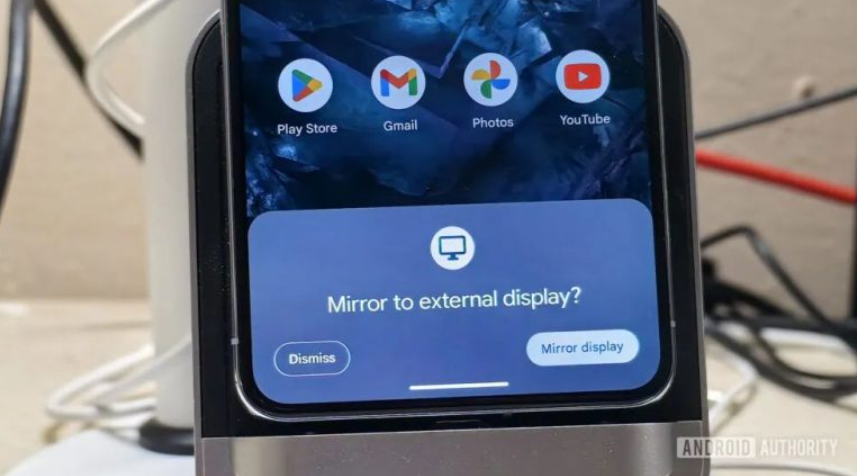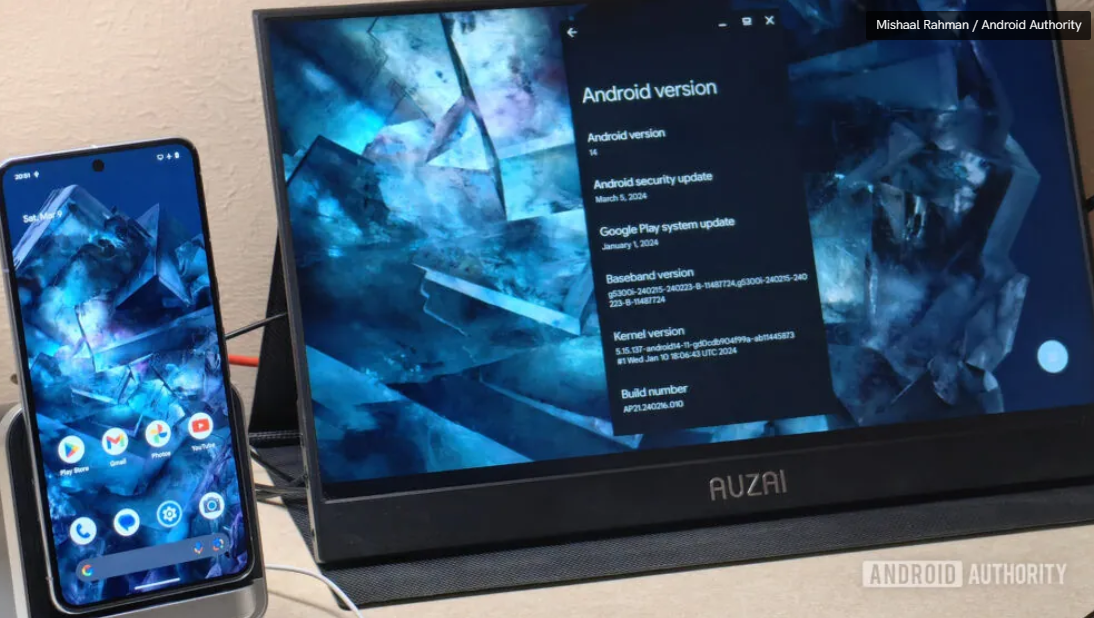 Mobile Tutorial
Mobile Tutorial
 Mobile News
Mobile News
 Google Pixel 8/Pro phones will support wired external displays for the first time
Google Pixel 8/Pro phones will support wired external displays for the first time
Google Pixel 8/Pro phones will support wired external displays for the first time
According to news on March 12, the Pixel 8/Pro series will become Google’s first mobile phone that can be connected to a wired external display. After updating to the Android 14 QPR3 Beta version system, it can be connected and used without any other operations.
Before the launch of Pixel 8/Pro, tipster Kamila Wojciechowska said that the phone supports USB DisplayPort Alt mode, allowing video output through the USB-C interface. Android news digger Mishaal Rahman recently discovered that after installing the Android 14 QPR3 Beta update, users can plug a USB-C to USB-C or HDMI video cable into the phone, plug the other end into a compatible monitor, and the phone will pop up A dialog box asking if you want to mirror your phone's screen to an external display.
 Rahman noted that the existing desktop mode is very rudimentary, but Google is apparently working on a more powerful version that is expected to launch with Android 15 this fall, not ruled out as a Pixel 9 series One of the possible selling points. Unfortunately, video output is not available on other Pixel devices, and Google has disabled DisplayPort Alt Mode at the hardware level, with the Pixel 8 and Pixel 8 Pro being the first phones to offer hardware support. We will continue to pay attention to the subsequent progress of this feature.
Rahman noted that the existing desktop mode is very rudimentary, but Google is apparently working on a more powerful version that is expected to launch with Android 15 this fall, not ruled out as a Pixel 9 series One of the possible selling points. Unfortunately, video output is not available on other Pixel devices, and Google has disabled DisplayPort Alt Mode at the hardware level, with the Pixel 8 and Pixel 8 Pro being the first phones to offer hardware support. We will continue to pay attention to the subsequent progress of this feature. The above is the detailed content of Google Pixel 8/Pro phones will support wired external displays for the first time. For more information, please follow other related articles on the PHP Chinese website!

Hot AI Tools

Undresser.AI Undress
AI-powered app for creating realistic nude photos

AI Clothes Remover
Online AI tool for removing clothes from photos.

Undress AI Tool
Undress images for free

Clothoff.io
AI clothes remover

Video Face Swap
Swap faces in any video effortlessly with our completely free AI face swap tool!

Hot Article

Hot Tools

Notepad++7.3.1
Easy-to-use and free code editor

SublimeText3 Chinese version
Chinese version, very easy to use

Zend Studio 13.0.1
Powerful PHP integrated development environment

Dreamweaver CS6
Visual web development tools

SublimeText3 Mac version
God-level code editing software (SublimeText3)

Hot Topics
 Google files for trademark for iconic 'G” logo on back of Pixel phones
Mar 20, 2024 am 09:13 AM
Google files for trademark for iconic 'G” logo on back of Pixel phones
Mar 20, 2024 am 09:13 AM
According to news on March 19, Google Pixel series smartphones have had the letter "G" logo in the center of the back for many years. However, Google only recently submitted an application to register the trademark to the United States Patent and Trademark Office (USPTO). Notice that from the launch of the original Pixel phone in 2016 to the Pixel 8 in 2023, all Pixel devices have this highly recognizable "G" logo. Although the appearance designs of smartphones are constantly updated, brand logos tend to maintain long-term consistency, such as the Apple logo on the back of Apple's iPhone and the Samsung logo on Samsung's Galaxy series of mobile phones. The "G" logo of the Google Pixel series was originally located at the bottom of the back of the phone.
 The predecessor of Pixel Fold, Google's canceled folding screen phone 'Pipit” appears
Jun 30, 2024 am 11:06 AM
The predecessor of Pixel Fold, Google's canceled folding screen phone 'Pipit” appears
Jun 30, 2024 am 11:06 AM
According to news on June 30, Google’s entry into the field of folding screen mobile phones did not start with Pixel Fold. As early as a year before the release of Pixel Fold, Google had prepared a prototype of a folding screen mobile phone, but it failed to be launched due to various reasons. Recently, spy photos and some specifications of a foldable screen phone code-named “pipit” have surfaced. The "pipit" design is very similar to the Pixel Fold, with the same screen ratio, bezels, hinges, and frosted glass back. The main difference is the camera module. The "pipit" uses an integrated glass design similar to the Pixel 6, while the Pixel Fold uses a separate metal camera module similar to the Pixel 7 Pro. This "pipit" prototype appeared in a certain
 It is revealed that Google's new flagship phones and tablets are all equipped with satellite communications, and Android 15 natively supports satellite networks.
Apr 15, 2024 pm 05:25 PM
It is revealed that Google's new flagship phones and tablets are all equipped with satellite communications, and Android 15 natively supports satellite networks.
Apr 15, 2024 pm 05:25 PM
According to news on April 15, digital blogger @digitalchat.com posted today that Google’s new flagship phones, new folding screen phones, and 5G tablets are all equipped with satellite communications, and the bottom layer of Android 15 natively supports satellite networks. According to previous reports, Google insiders revealed that the Pixel 9 series mobile phones will support emergency satellite communication functions, which are based on Samsung modem 5400. In addition, the next generation Pixel Fold and 5G tablets will also be equipped with this modem and are expected to support satellite communications. Previously, in the second developer preview version of Android 15 (Developer Preview 2), Google further expanded the Android system’s support for satellite connection functions and will support the use of satellite connections to send and receive information. number
 Google Pixel 8/Pro phones will support wired external displays for the first time
Mar 12, 2024 pm 09:19 PM
Google Pixel 8/Pro phones will support wired external displays for the first time
Mar 12, 2024 pm 09:19 PM
According to news on March 12, the Pixel8/Pro series will become Google’s first mobile phone that can be connected to a wired external display. After updating to the Android14QPR3Beta version system, it can be connected and used without any other operations. Before the launch of Pixel 8/Pro, whistleblower Kamila Wojciechowska said that the phone supports USB Display Port Alt mode, allowing video output through the USB-C interface. Android news digger Mishaal Rahman recently discovered that after installing the Android 14QPR3 Beta update, users can plug a USB-C to USB-C or HDMI video cable into the phone and plug the other end into
 Reverse wireless charging function of Google Pixel 9 series mobile phones is limited: it cannot be used while charging
Sep 02, 2024 pm 04:43 PM
Reverse wireless charging function of Google Pixel 9 series mobile phones is limited: it cannot be used while charging
Sep 02, 2024 pm 04:43 PM
According to news on September 2, a convenient feature of Google's Pixel5 to Pixel8 series - Battery Share, also known as reverse wireless charging, has been adjusted in this year's Pixel9 series. It is understood that this feature has been introduced since Pixel 5, allowing users to use their mobile phones as wireless charging pads to charge other devices. In previous models of the Pixel 9 series, users could use reverse wireless charging while charging, which would not affect their battery life. However, Google has tweaked this feature in this year's Pixel 9 series. If you charge a Pixel 9 series phone with battery sharing enabled, the feature will be turned off and a message will appear.
 Taking the iPhone as an example, cross-app tracking can be blocked on Android phones
May 01, 2023 am 10:19 AM
Taking the iPhone as an example, cross-app tracking can be blocked on Android phones
May 01, 2023 am 10:19 AM
Following Apple's lead on the iPhone, Google announced plans to block cross-app tracking on Android phones, publishing a new report today. However, there are a number of issues with the report that suggest it may be a case of "the headlines give, and the small font takes away". The opening begins with confidence as Google plans to reduce cross-app tracking on Android phones. Google plans to adopt new privacy restrictions to reduce tracking by apps on Android smartphones, following Apple's move to impose restrictions on an advertising industry that secretly collects data from billions of mobile devices. Google's Android plan could accelerate the end of more than a decade of advertising practices across smartphones, including MetaPlatforms
 Google Pixel mobile phones will usher in smart touch functions, and the screen sensitivity will automatically adjust according to the environment
Feb 11, 2024 pm 06:12 PM
Google Pixel mobile phones will usher in smart touch functions, and the screen sensitivity will automatically adjust according to the environment
Feb 11, 2024 pm 06:12 PM
According to news on February 11, Google seems to be developing a new feature called "Adaptive Touch" for Pixel phones, which allows the touch sensitivity of the phone screen to automatically adjust according to the usage environment. This feature was discovered by Android developer Mishaal Rahman in the latest Android 14 beta version QPR3Beta1. The relevant code shows: "Touch sensitivity will automatically adjust to adapt to your environment, activity and screen protector." Note that the Pixel8 series is currently available The convenient "screen protector mode" can improve the touch sensitivity after applying the film. However, “Adaptive Touch” goes a step further and can adjust the sensitivity according to the user’s usage. Rahman speculates that "environment" may
 Finally on par with competing products, it is reported that Google Pixel 9 series mobile phones will use ultrasonic under-screen fingerprint recognition
Jul 12, 2024 am 03:00 AM
Finally on par with competing products, it is reported that Google Pixel 9 series mobile phones will use ultrasonic under-screen fingerprint recognition
Jul 12, 2024 am 03:00 AM
According to news on July 4, the past few generations of Google Pixel series mobile phones have always had some troublesome problems, such as the use of outdated camera sensors, lack of ultra-wide-angle lenses, non-equal-width screen borders on all four sides, and extremely slow charging speeds. . 1. The pain point of under-screen fingerprint recognition Fortunately, Google has solved the above problems, and the upcoming Pixel9 series will also make improvements to the long-term pain point of Pixel phones - under-screen fingerprint recognition that unlocks slightly slowly and is sometimes unreliable. According to Android Authority, sources revealed that Google plans to use ultrasonic under-screen fingerprint recognition technology in its upcoming new phones. 2. Pixel 6’s fingerprint recognition problem. Pixel 6 is Google’s first phone to adopt an under-screen fingerprint scanner.





